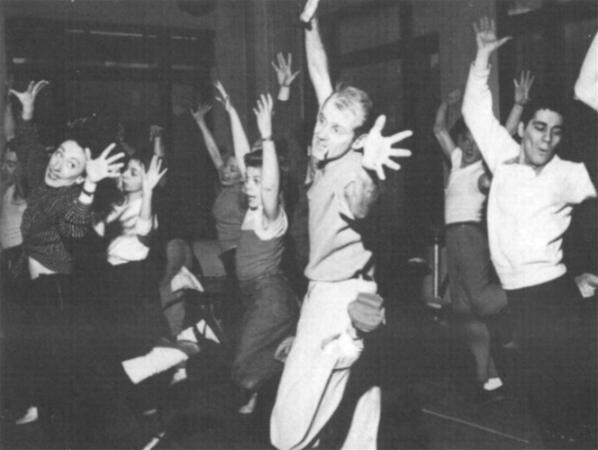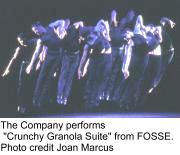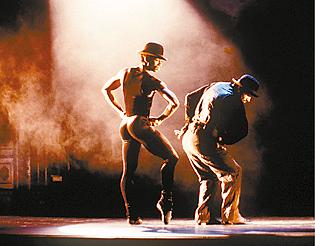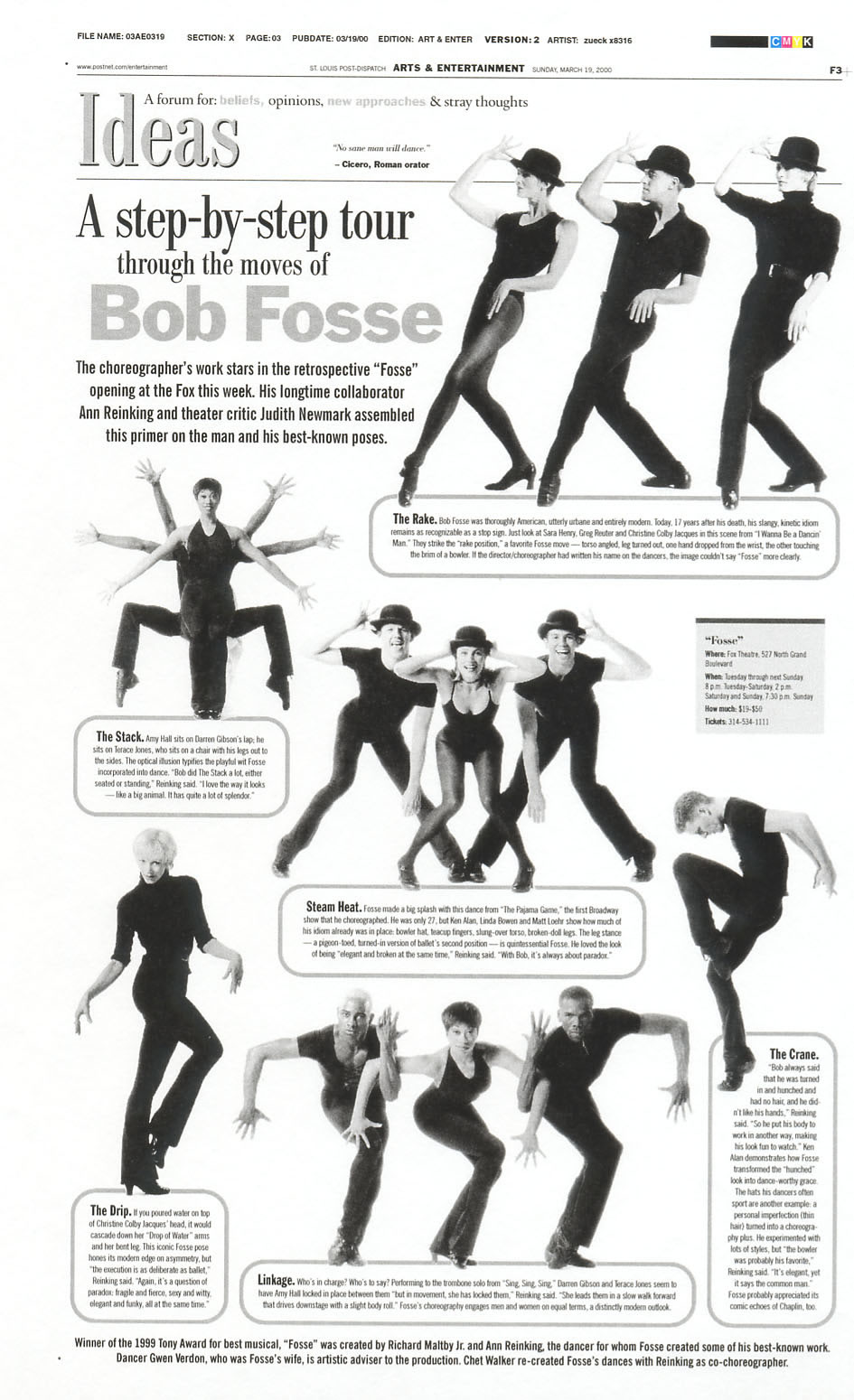
Fosse choreographing Damn
Yankees
Selected Commentary on Bob
Fosse
Jackie Demaline:
The short version of the Bob Fosse bio is that he was born into a star-struck
family in Chicago in 1927. By his early teens he was dancing in low-end burlesque
houses, where he could closely observe the raunch that became part of his
dance signature.
Ever a dancing man, post-WWII he found his way to Broadway and debuted in
Call Me Mister in 1947. Less than 10 years later he was choreographing on
Broadway where he met his wife Gwen Verdon. They consolidated their star
status with Sweet Charity.
His autobiographical fantasy All That Jazz touched on his womanizing, his
workaholism, the stormy marriage, his addictions. He died of heart failure
in 1987. He was 60.
His choreographic style is considered to be an outgrowth of his life experiences,
his interests and "in part came from his own restrictions," Ms. Reinking
says.
Those little, pure Fosse moves say a lot, whether it's a shrug of the shoulders
or holding a derby with fingers in proper teacup form.
Mr. Fosse didn't like his balding head, hence the hats. He was slightly
round-shouldered (note the shrugs) and pigeon-toed (watch for the turned-in
feet).
There was almost always tension in his choreography. Longtime Fosse dancer
Anne Reinking points to "Hey, Big Spender" from Sweet Charity in which the
ladies of the evening are lined up at a bar. From the chest up, the pose
references the posture of classical ballet, but beneath the bar the legs
are akimbo. "It's called the Broken Doll,” she says. "It's beauty but
it's busted."
She quickly adds that's just one side of Fosse. "The same man who choreographed
Cabaret also did "Pardon Me, Miss, Have You Ever Been Kissed by a Real Live
Girl."
Somehow it all came together in a way that was unmatched. "You can't readily
explain brilliance," Ms. Reinking says. "It's innate. I used to stare at
the top of his head and say, "Where does it come from?'
"

Keith Garebian:
Fosse is a choreographer who pushed the dancer's
body beyond self-evident limits in a pursuit of eroticism that somehow managed
to be elegant even when teasingly perverse, innocent when sophisticatedly
dynamic, and joyous even when streaked with cynicism.
Fosse learned a lot of his wicked humour from Jack Cole, one of the most
prominent choreographers in Hollywood. Exotic, flamboyant, jazzy, and highly
sexual, Cole's choreography had the audacity to be extravagant, so Fosse
was instinctively drawn to it. Fosse, however, outstripped Cole, becoming
a greater teacher and choreographer than he himself was a dancer--not because
he couldn't express what glowed in his imagination, but because his own physical
appearance did not admit him to the top echelon of screen or stage virtuosos
such as Astaire, Kelly, O'Connor, or Gower Champion. So, unable to achieve
what he wanted for himself, he set out to create other stars and to show
other dancers how to attain the highest sexual charge, the wittiest
razzle-dazzle, the most alluring and tender softshoe, and explosive cabaret
numbers.
The Fosse signature is indelible. It takes form most typically through dancers
in black bowler hats, black tops and tights, and white gloves, as they begin
with shoulder rolls, pelvic thrusts, and knees, elbows, and wrists bent at
unlikely angles. Finger snaps and the tiniest toe movements and slides assist
syncopation, and as the dancers slink and slither, do knee slides and awesome
back extensions, they segue into the distinctive Fosse idiom: bandit positions,
broken doll legs and torsos, sway backs, crane positions, tea-cup finger
semaphores, and drip positions. Now all this sounds esoteric or pedantically
lifeless on the page, but it isn't so on stage where the lexicon moves into
life, demonstrating its free enlargement on vaudevillean and burlesque roots
and earlier choreographic styles. But it's not sheer enlargement or pastiche;
it's a new expression, a new language that survives parody much better than
an Agnes de Mille or a Jack Cole or a Jerome Robbins mode
does.

Cassel Miles (right)
as "Mr. Bojangles" from FOSSE
nodanw.com -- biographies:
The son of a vaudevillian, Bob Fosse was born into the theatre. At 13 he
was already touring with his own dance act, called The Riff Brothers. At
15 he choreographed his first number in a night-club, in which girls manipulated
strategically-placed ostrich feathers to Cole Porter's 'That Old Black Magic'.
It was the kind of sexual suggestiveness which would become a trademark of
Fosse's choreography.
After a spell in the US Navy, Fosse put in two years in acting school before
heading out on the road in the chorus of Call Me Mister in 1948. Two years
in the chorus brought him to Broadway in the revue Dance Me A Song. Then
Hollywood beckoned. 'I had fantasies of becoming the next Fred Astaire,'
admitted Fosse, years later. After small parts in three films, including
Kiss Me, Kate (1953), Fosse realised he was going nowhere and headed back
to Broadway. That was when he got his big break.
Veteran director and playwright George Abbott took a chance on the young
man for the choreography of The Pajama Game (1954). Fosse's ground-breaking
staging of 'Steam Heat' was the talk of New York and the show became a huge
hit. The number contained elements which were to become recognisable as Fosse's
choreographic signature: small groups of dancers, drilled down to the lift
of an eyebrow, executing steps which are sometimes disjointed, sometimes
tortuously slow-motion - movement which seems to take the human body apart
and make each piece work separately.
Mirroring his autobiographical movie, All That Jazz (1979), Fosse himself
died just moments before the curtain up on the triumphant revival of Sweet
Charity.
|



